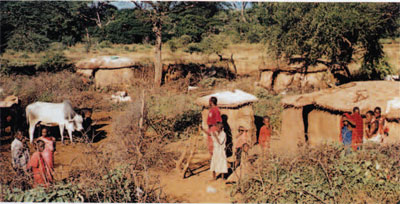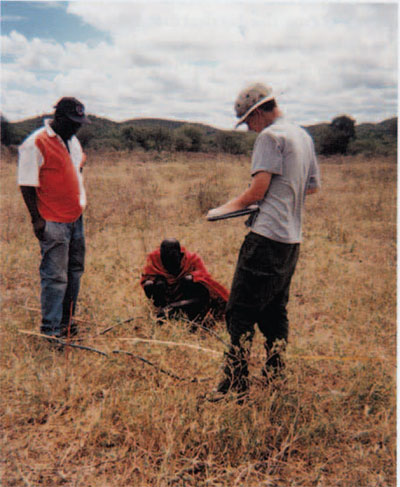
The two main components of archaeological fieldwork are locating sites and then excavating them. Site survey is necessary to locate culturally important areas for excavation unless they remain obvious and well known to locals. At the opposite end of the spectrum are sites like bomas, the traditional settlements of the Maasai people of Kenya. These housing clusters, built from wood, thatch, and dung, are typically occupied for 10—go years before being abandoned, and are visible as a patch of grass go years after abandonment. Modern archaeological investigations about the ancient inhabitants of East Africa depend heavily on ethnoarchaeological studies of the current pastoral peoples of the area to learn about how dependence on animal herds could manifest itself in the material record. The Maasai are prototypical pastoralists and have been the focus of many research studies. However, one major problem faced by ethnoarchaeologists is determining the location of abandoned Maasai bomas, a problem my research addresses.
The settlements of pastoral peoples tend to be ephemeral and leave no surface traces, although the materials of the Lomas do preserve when buried and can be identified during excavation. Site survey is additionally complicated by the presence of ground cover; while freshly plowed fields allow an easy assessment of their archaeological potential, the thick grass of the African savanna obscures any traces of past human occupation. Expensive and time-consuming survey techniques are often used in such an environment to locate sites. These range from digging test pits at specified intervals to using remote-sensing methods and chemical prospecting techniques which analyze soils for nitrogen and phosphorus levels. My idea was to take advantage of the dense vegetation and look for abandoned bomos by studying the ground cover itself. The plants growing over the abandoned settlements are different from those in the surrounding grassland, and it was my goal to identify the important indicator species that might, by their presence, signal the location of a bomas.
I traveled to Kenya in 1999 to test appropriate plant survey methods and to familiarize myself with the native flora of southern Kenya. The trip coincided with the fieldwork of Kathleen Ryan, a research scientist in Maasai ethnoarchaeology at the Museum Applied Science Center for Archaeology, whose ethnobotany project I had participated in previously. Through Kathleen I was able to arrange with the East African Herbarium at the National Museums of Kenya in Nairobi for access to their plant collections to aid in the identification of my specimens; the Herbarium now also serves as a repository for these specimens. The research area was in the Kajiado district near the town of Rombo, in the foothills of Mt. Kilimanjaro. Together with Maasai informants, we identified two Lomas for survey, one of which had been abandoned for 30 years and the other for 50.

While many of the plant species within the Lomas were the same as those outside, there were noticeable differences in their frequency. In particular, the grass Emuruo (Cynodon docylon [L.] Pers., commonly known as Bermuda grass) was the most prevalent plant within both Lomas but was rare outside them. This grass renders the abandoned Lomas readily noticeable as a circle of bright green grass among the more variable surrounding vegetation. This difference is most evident after the spring rains when the ground cover is lush, as Emurua is a tenacious perennial that begins to grow back as soon as the ground gets wet.
The predominance of Emuruo within abandoned settlements is striking, but was easily explained by ole Coring, a Maasai elder and our main informant. In early summer, after the long rains, Emuruo is the preferred fodder for cattle because of its prevalence and nutritive qualities. Household livestock are corralled within the Loma at night, so corral areas fill up with large amounts of dung. While some of this dung is used for purposes such as building construction, the majority of it is left in the boma, one of the factors leading to abandonment.
After a Lomo is deserted, the seeds in the dung sprout and overgrow the area. Thus the plants growing in an abandoned Como are representative of the plants preferred for grazing.
My research complements other ethnoarchaeological work, such as that of Ruth ShahackGross of Washington University in St. Louis. who has conducted research on soil chemistry and micromorphology of abandoned bomas (publications forthcoming). She aims to identify the presence of particular species (sheep, goats, or cattle) in specific areas of the borne to aid in our understanding of settlement layout and use of space. She plans to extend this ethnoarchaeological research to the study of prehistoric sites, allowing archaeologists to test questions about prehistoric settlement patterning and subsistence directly and quantitatively.
Botanical survey appears to be a useful ethnoarchaeological precursor to site survey in East Africa. The method seems to provide accurate results with relatively little effort in the field, and once a data set for a particular terrain has been established, the indicator plant species should aid in site survey. There are, however, limitations to the conclusions that can be drawn from these data. I have not been able to determine how the length of time the Lorne has been abandoned affects the results. While I noticed differences between the two bomas, it is unclear whether those are due to duration of abandonment or to local environmental factors, or to some combination of the two. The effect of the seasons also needs to be further investigated to determine how applicable this technique would be in the dry season. Overall, however, botanical survey is a promising and productive field of analysis that would benefit from further study in all parts of the world.
Mac Marston
Research Assistant, MASCA,
University of Pennsylvania Museum
